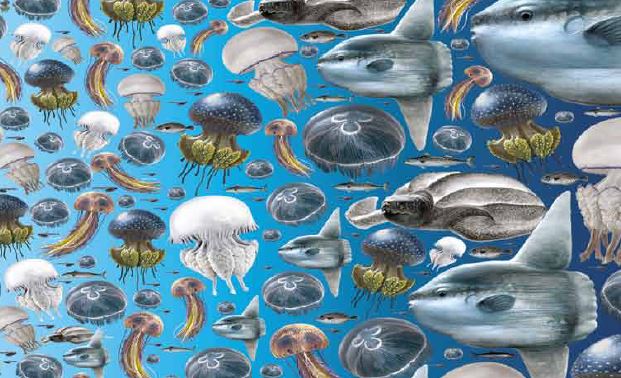Review of jellyfish blooms in the Mediterranean and Black Sea
Review of jellyfish blooms in the Mediterranean and Black Sea

Cover photo and design
Cover picture: “Decrease of large fish releases jellyfish from competition with their larvae. Increased jellyfish availability favors medusivorous species, whose populations increase at the expenses of gelatinous plankton” art by A. Gennari, graphics by F. Tresca.
Cover design: A. Nastasi.
STUDIES AND REVIEWS No. 92 GENERAL FISHERIES COMMISSION FOR THE MEDITERRANEAN
REVIEW OF JELLYFISH BLOOMS IN THE MEDITERRANEAN AND BLACK SEA
Ferdinando Boero
FOOD AND AGRICULTURE ORGANIZATION OF THE UNITED NATIONS Rome, 2013
The designations employed and the presentation of material in this information product do not imply the expression of any opinion whatsoever on the part of the Food and Agriculture Organization of the United Nations (FAO) concerning the legal or development status of any country, territory, city or area or of its authorities, or concerning the delimitation of its frontiers or boundaries. The mention of specific companies or products of manufacturers, whether or not these have been patented, does not imply that these have been endorsed or recommended by FAO in preference to others of a similar nature that are not mentioned.
The views expressed in this information product are those of the author(s) and do not necessarily reflect the views or policies of FAO.
ISBN 978-92-5-107457-2
© FAO 2013
FAO encourages the use, reproduction and dissemination of material in this information product. Except where otherwise indicated, material may be copied, downloaded and printed for private study, research and teaching purposes, or for use in non-commercial products or services, provided that appropriate acknowledgement of FAO as the source and copyright holder is given and that FAO’s endorsement of users’ views, products or services is not implied in any way.
All requests for translation and adaptation rights, and for resale and other commercial use rights should be made via www.fao.org/contact us/licence- request or addressed to Этот адрес электронной почты защищён от спам-ботов. У вас должен быть включен JavaScript для просмотра..
FAO information products are available on the FAO website (www.fao.org/ publications) and can be purchased through Этот адрес электронной почты защищён от спам-ботов. У вас должен быть включен JavaScript для просмотра..
Gelatinous plankton is formed by representatives of Cnidaria (true jellyfish), Ctenophora (comb jellies) and Tunicata (salps). The life cycles of gelatinous plankters are conducive to bloom events, with huge populations that are occasion ally built up whenever conditions are favorable. Such events have been known since ancient times and are part of the normal functioning of the oceans. In the last decade, however, the media are reporting on an increasingly high number of gelatinous plankton blooms. The reasons for these reports is that thousands of tourists are stung, fisheries are harmed or even impaired by jellyfish that eat fish eggs and larvae, coastal plants are stopped by gelatinous masses. The scientific literature seldom reports on these events, so time is ripe to cope with this mismatch between what is happening and what is being studied. Fisheries scientists seldom considered gelatinous plankton both in their field-work and in their computer-generated models, aimed at managing fish populations. Jellyfish are an important cause of fish mortality since they are predators of fish eggs and larvae, furthermore they compete with fish larvae and juveniles by feeding on their crustacean food. The Black Sea case of the impact of the ctenophore Mnemiopsis leydi on the fish populations, and then on the fisheries, showed that gelatinous plankton is an important variable in fisheries science and that it cannot be overlooked. The aim of this report is to review current knowledge on gelatinous plankton in the Mediterranean and Black Sea, so as to provide a framework to include this important component of marine ecosystems in fisheries science and in the management of other human activities such as tourism and coastal development. Fact sheets on the most important gelatinous plankters of the Mediterranean and Black Seas are included as an appendix.